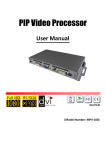Download USER MANUAL - All Pro Sound
Transcript
Kramer Electronics, Ltd. USER MANUAL Model: VP-725DS Presentation Switcher / Scaler Introduction Contents 1 Introduction 1 2 Getting Started 1 3 Overview 2 4 Your VP-725DS Presentation Switcher / Scaler 5 5.1 5.2 Connecting the VP-725DS Presentation Switcher / Scaler Connecting a PC Connecting the VP-725DS via the ETHERNET port 8 9 10 6 6.1 6.2 Understanding the Presentation Switcher / Scaler Understanding the Video Group Mode/Scaler Mode Understanding the PIP Button Feature 12 12 12 6.2.1 6.2.2 6.2.3 6.2.4 6.2.5 Activating the PIP Feature PIP Characteristics Toggling between the PIP and the Screen Source (SWAP) Resizing the PIP Moving the Position of the PIP 13 14 14 14 14 6.3 Locking and Unlocking the Front Panel 15 7 7.1 Operating the Presentation Switcher / Scaler Switching an Input 16 16 7.1.1 7.1.2 Freezing the Image Displaying a Blank Screen 16 17 7.2 Choosing the Output Resolution 18 8 8.1 Controlling the VP-725DS Presentation Switcher / Scaler Operating via the OSD MENU Screen 19 19 8.1.1 8.1.2 8.1.3 8.1.4 Controlling the Brightness and Contrast Controlling the Gamma and Color Selecting the Source Controlling the Geometry 20 20 21 24 8.1.4.1 8.1.4.2 Adjusting the Zoom Ratio Adjusting the Zoom Position 26 27 8.1.5 Configuring via the Utility Screens 28 8.1.5.1 8.1.5.2 8.1.5.3 8.1.5.4 8.1.5.5 8.1.5.6 8.1.5.7 Choosing the Graphic Utility Settings Choosing the Video Utility Settings Choosing the PIP Utility Settings Choosing the Seamless Switch Utility Settings Choosing the OSD Utility Settings Choosing the Output Utility Settings Choosing Factory Reset 28 30 31 32 33 35 37 8.1.6 Verifying Configuration Details via the Information Screen 37 4 i Introduction 8.2 8.3 8.4 Operating via the LCD Display Operating via the Infra-red Remote Control Transmitter Operating via ETHERNET 38 38 41 9 Technical Specifications 41 10 VP-725DS Communication Protocol 41 Figures Figure 1: VP-725DS Presentation Switcher / Scaler Figure 2: Connecting the PC Figure 3: RJ-45 PINOUT Figure 4: Connecting the VP-725DS Presentation Switcher / Scaler Figure 5: OSD PIP Status Figure 6: OSD SWAP Status Figure 7: Locking / Unlocking the Front Panel Figure 8: OSD Input Status Figure 9: OSD Output Status Figure 10: Controlling the Brightness and Contrast Figure 11: Menu Screen Icons Figure 12: Controlling the Gamma and Color Figure 13: Gamma, Color Temperature/Manager User 1/2 Screen Figure 14: Selecting the Source Figure 15: Selecting the Search Figure 16: Selecting the Group Figure 17: Selecting the Source Figure 18: Geometry Screen Figure 19: Geometry (Aspect Ratio) Screen Figure 20: Geometry (Zoom) Screen Figure 21: OSD Enlarge Status Figure 22: Zoom Ratio Adjustment Example Figure 23: Zoom Position Adjustment Example Figure 24: Geometry (Zoom Ratio) Screen Figure 25: Geometry (Zoom Position Adjustment) Screen Figure 26: Geometry (Keystone) Screen Figure 27: Utility Screen Figure 28: Choosing the Graphic Utility Settings Figure 29: Graphic Setting Color Format Utility Screen Figure 30: Choosing the Video Utility Settings Figure 31: Video Setting Standard Utility Screen Figure 32: Choosing the PIP Utility Settings Figure 33: Choosing the Seamless Switch Utility Settings Figure 34: Choosing the OSD Utility Settings Figure 35: OSD Size Utility Screen ii 5 9 10 11 13 14 15 16 18 19 20 20 21 21 23 23 23 24 25 25 26 26 26 27 27 28 28 29 29 30 30 31 32 33 33 KRAMER: SIMPLE CREATIVE TECHNOLOGY Introduction Figure 36: OSD Blank Color Utility Screen Figure 37: Choosing the Output Utility Settings Figure 38: Output Setting Resolution Utility Screen Figure 39: Output Setting Refresh Rate Utility Screen Figure 40: Output Setting User Mode Setting Utility Screen Figure 41: Factory Reset Utility Screen Figure 42: Information Screen Figure 43: Example of how to use the LCD Display Figure 44: Infra-red Remote Control Transmitter 34 35 36 36 36 37 37 38 39 Tables Table 1: Front Panel VP-725DS Presentation Switcher / Scaler Features Table 2: Rear Panel VP-725DS Presentation Switcher / Scaler Features Table 3: Crossover Cable RJ-45 PINOUT Table 4: Straight-through Cable RJ-45 PINOUT Table 5: Controlling the Brightness and Contrast Table 6: Controlling the Gamma and Color Table 7: Selecting the Source Table 8: Controlling the Geometry Table 9: Choosing the Graphic Utility Settings Table 10: Choosing the Video Utility Settings Table 11: Choosing the PIP Utility Settings Table 12: Choosing the Seamless Switch Utility Settings Table 13: Choosing the OSD Utility Settings Table 14: Choosing the Output Utility Settings Table 15: User Mode Setting Definitions Table 16: Infra-red Remote Control Transmitter Functions Table 17: Technical Specifications of the VP-725DS Presentation Switcher / Scaler 6 7 10 10 20 21 22 24 29 30 31 32 33 35 37 40 41 iii Introduction 1 Introduction Welcome to Kramer Electronics (since 1981): a world of unique, creative and affordable solutions to the infinite range of problems that confront the video, audio and presentation professional on a daily basis. In recent years, we have redesigned and upgraded most of our line, making the best even better! Our 300-plus different models now appear in 8 Groups1, which are clearly defined by function. Congratulations on purchasing your Kramer VP-725DS Presentation Switcher, which is ideal for the following typical applications: Projection systems in conference rooms, board rooms, auditoriums, hotels, and churches Any application in which high quality conversion and switching of multiple and different video signals to graphical data is required for projection and large display purposes The package includes these items: VP-725DS Presentation Switcher / Scaler Power cord2 Infra-red remote control transmitter (including the required battery) Null-modem adapter This user manual3 2 Getting Started We recommend that you: Unpack the equipment carefully and save the original box and packaging materials for possible future shipment Review the contents of this user manual Use Kramer high performance high resolution cables4 1 GROUP 1: Distribution Amplifiers; GROUP 2: Video and Audio Switchers, Matrix Switchers and Controllers; GROUP 3: Video, Audio, VGA/XGA Processors; GROUP 4: Interfaces and Sync Processors; GROUP 5: Twisted Pair Interfaces; GROUP 6: Accessories and Rack Adapters; GROUP 7: Scan Converters and Scalers; and GROUP 8: Cables and Connectors 2 We recommend that you use only the power cord that is supplied with the machine 3 Download up-to-date Kramer user manuals from the Internet at this URL: http://www.kramerelectronics.com/manuals.html 4 The complete list of Kramer cables is on our Web site at http://www.kramerelectronics.com (click “Cables and Connectors” in the Products section) 1 Overview 3 Overview The VP-725DS Presentation Switcher / Scaler is designed for a wide variety of presentation and multimedia applications. It is a true multi-standard video to graphics scaler and presentation switcher for a wide variety of presentation and multimedia applications. It consists of a very high quality scaler with many user-selectable pixel-rates including VGA (640x480), SVGA (800x600), XGA (1024x768), SXGA (1280x1024) and UXGA (1600x1200); high definition television HDTV (480p, 720p and 1080i); and several optimum plasma and LCD rates such as 852x1024i, 1024x1024i, 1366x768, 1365x1024, 1280x720, 720x483, 852x480, 1400x1050, 576P, 720x400, 832x624, 1024x800, 1152x864, 1152x870, 1152x900, 1280x960, 1280x768, 1024x576, as well as a user definable output mode1. In particular, the VP-725DS: Offers high quality de-interlacing 3:2/2:2 pull down2 Supports firmware upgrade via RS-232 Includes non-volatile memory that retains the last setting, after switching the power off and then on again Scales and zooms (to up to 400% of the original size) Digitally reprocesses the signal to correct mastering errors, and regenerates the video at a chosen line and pixel rate format, providing, for example, native-resolution video for LCD, DLP and Plasma displays Facilitates scaling of graphics resolutions to other resolutions Incorporates a unique graphics-scaling engine with image enhancement algorithms, which are built into the firmware Is specifically designed to improve video quality by reducing chroma noise Includes an OSD (on-screen display) for making the adjustments that can be located anywhere on the screen, and can be doubled in size. The OSD can be used to deactivate the source prompt, choose the color of the blank screen, and choose from three seamless switching transition speeds Consists of 5 video groups—composite video, s-Video, component video (RGB or YPbPr), DVI-D and VGA—and each group has 4 inputs (except for DVI which has 2 inputs) 1 Recommended for advanced users only – non-standard settings may not be recognized by the display device 2 Accommodates the frame-rate of a converted movie (24 frames per second) to video frequencies (25 frames per second (PAL); 30 frames per second (NTSC) 2 KRAMER: SIMPLE CREATIVE TECHNOLOGY Overview Has multi-standard video support; supports VESA standards; HDTV standards and other popular resolutions on the input. Does not support1 HDCP (High bandwidth Digital Content Protection) on the DVI2 Features two modes of operation: Video Group Mode and Scaler Mode. These modes function simultaneously and independently (except for DVI: once a DVI input is selected in the Scaler Mode, that DVI input selection cannot be changed in the Video Group Mode) Video Group Mode selects the input from each group: CV, YC, Component, VGA, DVI for switching to its local (group) output Scaler Mode converts the selected input (one of 18) to the SCALED OUTPUTS Includes a front panel lock, as well as a separate OSD lock In addition to providing an up- or down- scaled output of the selected (one of 18) inputs, also functions as 4x1 switchers for each video group (2x1 for DVI) Has ProcAmp3 controls for the scaler output Lets you freeze the image at any instant Lets you select the output colorspace (RGB or YPbPr) Has a text overlay feature4 for easy insertion of subtitles, karaoke script, text banners, and the like Includes a built-in Picture-In-Picture (PIP) inserter5 (letting you insert a video source into a graphics background or vice versa. This PIP image may be positioned and sized anywhere on the screen, or displayed as 2 images side-by-side (Split-Screen) The VP-725DS: Comes in a rugged, professional 19" 3U rack-mountable metal enclosure Uses a universal 100-240VAC automatic power supply 1 A method of security encryption (developed by Intel and Silicon Image) 2 An HDCP source would show up as a very snowy, noisy picture at the output 3 Processing amplification enables adjustment of different video and audio signal parameters 4 The Text Overlay Application Program is included on the CD / is available for download at this URL: http://www.kramerelectronics.com/searchdx.html. This user-friendly program may be used to generate and send text to be displayed on the scaled output 5 See section 6.1 3 Your VP-725DS Presentation Switcher / Scaler Control the VP-725DS: From the front panel user-friendly menu-driven OSD (see section 8.1) From the front panel high contrast LCD Display (see section 8.2) Remotely, from the infra-red remote control transmitter (see section 8.3) Via Ethernet (see section 8.4) Remotely, via RS-232 Achieving the best performance means: Connecting only good quality connection cables, thus avoiding interference, deterioration in signal quality due to poor matching, and elevated noise levels (often associated with low quality cables) Avoiding interference from neighboring electrical appliances and positioning your VP-725DS away from moisture, excessive sunlight and dust 4 Your VP-725DS Presentation Switcher / Scaler Figure 1, Table 1 and Table 2 define the VP-725DS: 4 KRAMER: SIMPLE CREATIVE TECHNOLOGY Your VP-725DS Presentation Switcher / Scaler Figure 1: VP-725DS Presentation Switcher / Scaler 5 Your VP-725DS Presentation Switcher / Scaler Table 1: Front Panel VP-725DS Presentation Switcher / Scaler Features INPUT SELECTOR # 1 2 3 Feature VGA Button DVI Button Function Selects one of the 4 VGA sources Selects one of the 2 DVI sources1 CV Button Selects one of the 4 CV sources 4 5 6 7 YC Button COMP Button POWER Switch IR Receiver / LED 8 9 FREEZE Button PIP Button 10 MENU Button Selects one of the 4 s-Video (Y/C) sources Selects one of the 4 Component sources Illuminated switch for turning the unit ON or OFF Green when the unit will accept IR remote commands; red in 2 standby mode Freezes the output video image3 3,4 Selects the picture-in-picture function 11 ENTER Button Displays the OSD Menu screen (or moves to the previous level in 3,5 the OSD screen) and locks/unlocks the front panel 3 Moves to the next level in the OSD screen 12 - Button 13 + Button Decreases the range by one step3 Increases the range by one step3 14 DOWN Button 15 UP Button Moves down one step (in the same level) in the OSD screen 3 Moves up one step (in the same level) in the OSD screen 16 OSD ON Button 17 LCD STATUS Display Activates/deactivates access to the OSD Menu3, 6 Displays the status 19 SCALER Button MODE SELECT 18 3 When selected shows which of the 18 video inputs has been selected to be scaled at the SCALED OUTPUTS, and facilitates the selection of an alternative video input for scaling VIDEO GROUP Button Shows which video input from each group is selected for switching, and facilitates the selection of an alternative video input from each group1 1 Note, that once a DVI input is selected in the Scaler Mode, that DVI input selection cannot be changed in the Video Group Mode 2 After pressing the POWER key on the remote control transmitter (see Figure 44). The machine is temporarily powered down except that the power switch (item 6) on the machine continues to illuminate 3 Scaler outputs only 4 See section 6.1 5 See section 6.3 6 The OSD ON front panel button is activated (illuminated) by default, and pressing the MENU front panel button (or the MENU key on the infra-red remote control transmitter (see Figure 44)) displays the OSD Menu. To block display of the OSD Menu, press the OSD ON front panel button (or the OSD key) to deselect the OSD ON front panel button (which is no longer illuminated); the OSD OFF status appears superimposed over the top right corner of the screen. However, deselecting the OSD ON front panel button during an OSD operation will not turn off the OSD Menu (even though the OSD OFF status appears superimposed over the top right corner of the screen), letting you complete the OSD operation 6 KRAMER: SIMPLE CREATIVE TECHNOLOGY Your VP-725DS Presentation Switcher / Scaler # 1 2 3 4 5 6 COMP COMP INPUTS OUTPUT Table 2: Rear Panel VP-725DS Presentation Switcher / Scaler Features Feature R/Pr BNC Connector B/Pb BNC Connector Function Connect to the component video acceptor or to an RGB acceptor G/Y BNC Connector R/Pr BNC Connector B/Pb BNC Connector Connect to the component video source or RGB source from 1 to 4 G/Y BNC Connector ETHERNET port 8 CV OUT BNC Connector Connects to the composite video acceptor 9 CV IN BNC Connectors Connects to the composite video sources from 1 to 4 10 VGA IN HD15 Connectors Connects to your LAN 1 7 Connects to the VGA (analog interface) graphics sources from 1 to 4 Connects to the VGA (analog interface) graphics acceptor 12 YC IN 4p Connectors Connects to the s-Video (Y/C) sources from 1 to 4 13 YC OUT 4p Connector Connects to the s-Video (Y/C) acceptor 14 DVI IN Connectors Connects to the DVI (digital video interface) graphics sources from 1 to 2 15 DVI OUT Connector 16 H BNC Connector Connects to the DVI (digital video interface) graphics acceptor 17 18 19 20 21 22 SCALED OUPUTS 11 VGA OUT HD15 Connector R/Pr BNC Connector V BNC Connector Connects to the component video or RGB acceptor G/Y BNC Connector B/Pb BNC Connector DVI Connector Connects to the DVI (digital video interface) graphics acceptor VGA HD15 Connector Connects to the VGA (analog interface) graphics acceptor 23 RS-232 DB 9 Connector Connects to PC or Serial Controller 24 Power Connector with FUSE AC connector enabling power supply to the unit 1 Local Area Network (that is, computers sharing a common communications line or wireless link, which often share a server within a defined geographic area) 7 Connecting the VP-725DS Presentation Switcher / Scaler 5 Connecting the VP-725DS Presentation Switcher / Scaler This section describes how to connect the VP-725DS. In particular, how to: Connect the VP-725DS rear panel (see this section) Connect the PC (see section 5.1) Connect the ETHERNET port (see section 5.2) Using the VP-725DS you can select any one of the 18 inputs and scale that input to up to three scaled outputs (at the identical resolution). To connect the VP-725DS, connect the following1 to the rear panel, as the example in Figure 4 illustrates: 1. Connect one or more of the following video sources: Up to 4 VGA graphics sources (for example, computers): VGA Source 1, VGA Source 2, VGA Source 3 and VGA Source 4 to the HD15 input connectors Up to 4 composite video sources2: CV Source 1, CV Source 2, CV Source 3, and CV Source 4 to the BNC input connectors Up to 4 s-Video sources2: YC Source 1, YC Source 2, YC Source 3, and YC Source 4 to the 4p input connectors Up to 4 component video (sometimes called YUV, or Y, B-Y, R-Y, or Y, Pb/Cb, and Pr/Cr ) sources or 4 RGB sources3: COMP Source 1, COMP Source 2, COMP Source 3, and COMP Source 4 to the 4 sets of 3 BNC connectors, G/Y, B/Pb, and R/Pr Up to 2 DVI4 graphics sources (for example, computers): DVI Source 1 and DVI Source 2 to the DVI connectors 2. Connect the CV OUT BNC connector, the YC OUT 4p connector, and the VGA OUT HD15 connector to the respective video inputs on the projector. 3. Connect the COMP OUTPUT BNC connectors: G/Y, B/Pb, and R/Pr to the respective component video inputs on the Plasma monitor. 4. Connect up to 3 SCALED OUTPUTS, as follows: Connect the RGBHV connectors (G/Y, B/Pb, R/Pr, H, and V) to the 1 Switch OFF the power on each device before connecting it to your VP-725DS. After connecting your VP-725DS, switch on its power and then switch on the power on each device 2 For example, VCR machines 3 For example, an HDTV satellite receiver to COMP Source 1, and a Betacam VCR machine (or an RGB camera) to COMP Source 4 4 Not HDCP sources 8 KRAMER: SIMPLE CREATIVE TECHNOLOGY Connecting the VP-725DS Presentation Switcher / Scaler RGBHV acceptor, for example, a Plasma monitor Connect the DVI connector to the DVI acceptor, for example, a projector. Connect the VGA connector to the VGA acceptor, for example, a monitor. 5. Connect the power cord1 (not illustrated in Figure 4). 6. Connect a PC (optional), see section 5.1. 7. Connect the ETHERNET port (optional), see section 5.2. 5.1 Connecting a PC You can connect a PC (or other controller) to the VP-725DS via the RS-232 port for remote control, and for upgrading the firmware. To connect a PC to a VP-725DS unit, using the Null-modem adapter provided with the machine (recommended): Connect the RS-232 DB9 rear panel port on the VP-725DS unit to the Null-modem adapter and connect the Null-modem adapter with a 9 wire flat cable to the RS-232 DB9 port on your PC To connect a PC to a VP-725DS unit, without using a Null-modem adapter: Connect the RS-232 DB9 port on your PC to the RS-232 DB9 rear panel port on the VP-725DS unit, forming a cross-connection2, as Figure 2 illustrates DB9 (FromPC) DB9 (To Presentation Switcher / Scaler) Figure 2: Connecting the PC 1 We recommend that you use only the power cord that is supplied with this machine 2 Also known as a Null-modem connection 9 Connecting the VP-725DS Presentation Switcher / Scaler 5.2 Connecting the VP-725DS via the ETHERNET port To connect the VP-725DS via the ETHERNET port, do the following: Connect the ETHERNET port of the VP-725DS to the LAN port of your PC, via a crossover cable with RJ-45 connectors, as Table 3 and Figure 3 define Figure 3: RJ-45 PINOUT Table 3: Crossover Cable RJ-45 PINOUT EIA /TIA 568A Side 2 PIN 1 2 3 4 5 6 7 8 EIA /TIA 568B Side 1 Wire Color Green / White Green Orange / White Blue Blue / White Orange Brown / White Brown PIN 1 2 3 4 5 6 7 8 Wire Color Orange / White Orange Green / White Blue Blue / White Green Brown / White Brown Pair 1 4 and 5 Pair 1 Pair 2 3 and 6 Pair 2 4 and 5 1 and 2 Pair 3 Pair 4 1 and 2 7 and 8 Pair 3 Pair 4 3 and 6 7 and 8 If connecting the ETHERNET port of the VP-725DS to the LAN port on a network hub or network router, use a straight-through cable with RJ-45 connectors, as Table 4 defines Table 4: Straight-through Cable RJ-45 PINOUT EIA /TIA 568A Side 2 PIN 1 2 3 4 5 6 7 8 10 Wire Color Orange / White Orange Green / White Blue Blue / White Green Brown / White Brown EIA /TIA 568B Side 1 PIN 1 2 3 4 5 6 7 8 Wire Color Orange / White Orange Green / White Blue Blue / White Green Brown / White Brown KRAMER: SIMPLE CREATIVE TECHNOLOGY Connecting the VP-725DS Presentation Switcher / Scaler Figure 4: Connecting the VP-725DS Presentation Switcher / Scaler 11 Understanding the Presentation Switcher / Scaler 6 Understanding the Presentation Switcher / Scaler The VP-725DS includes the following front panel buttons: A set of 18 INPUT SELECTOR buttons A set of 2 MODE SELECT buttons1 A FREEZE button (see section 7.1.1) A PIP button (see section 6.1) A set of 7 OSD buttons (described in Table 1): OSD ON, MENU, ENTER, -, +, UP, and DOWN 6.1 Understanding the Video Group Mode/Scaler Mode This is a machine with an 18x1:3 switcher for the Scaler, as well as individual video switchers for the 5 Video Groups: composite video, s-Video, component video (RGB or YPbPr), DVI-D and VGA. When the VP-725DS is in use, both modes operate simultaneously, as well as independently. That is, the Scaler output is available even when switching in the Video Group mode, and visa-versa (except for DVI: once a DVI input is selected in the Scaler Mode, that DVI input selection cannot be changed in the Video Group Mode). 6.2 Understanding the PIP Button Feature The Picture-in-Picture inserter (PIP) is used for the simultaneous display of video and graphic sources, and lets you display: An inserted video source2 PIP over a graphic source3 An inserted graphic source3 PIP over a video source2 Your Presentation Switcher / Scaler automatically recognizes and displays only the relevant sources, as the following 2 examples illustrate: Choosing the AV 1 PIP source when the VGA input is selected, will insert the composite video source over the VGA graphic displayed on the screen. You can choose a component4, YC 1, YC 2 or AV 2 PIP source5 1 VIDEO GROUP MODE SELECT: selects the video input from each group for switching, and SCALER MODE SELECT: converts the selected video input (one of 18) at each of the SCALED OUTPUTS 2 That is, composite, s-Video or component 3 That is, DVI, VGA or component 4 At video frequencies 5 As long as it is connected and switched on. Otherwise, choosing it will display a blank screen 12 KRAMER: SIMPLE CREATIVE TECHNOLOGY Understanding the Presentation Switcher / Scaler (instead of the AV 1). You cannot choose VGA 1, VGA 2 or DVI1 Choosing the VGA 1 PIP source when the AV 1 input is selected, will insert the VGA graphic source over the composite video displayed on the screen. You can choose a component2, VGA 2 or DVI PIP source3 (instead of the VGA 1). You cannot choose AV 2, YC 1, or YC 2 6.2.1 Activating the PIP Feature To activate the PIP (which illuminates the PIP button), do one of the following: Press the PIP button Switch on the PIP functionality via the OSD Menu Press the PIP key on the remote control transmitter (see Figure 44) When the Source Prompt is ON, the PIP is enclosed by an orange frame, and the OSD PIP status appears superimposed over the top right corner of the screen for a few seconds, as Figure 5 illustrates. After a few seconds4, the orange frame and the OSD PIP status automatically disappear5. Activating the PIP subsequently cycles between the PIP with the orange frame and no PIP. Figure 5: OSD PIP Status When the Source Prompt is OFF, activating the PIP toggles between the PIP (with no frame and no OSD PIP status) and no PIP. 1 As these are graphics sources and you cannot insert a graphics PIP over a graphics source 2 At graphic frequencies 3 As long as it is connected and switched on. Otherwise, choosing it will display a blank screen 4 By default, 20 seconds. But you can reset the timeout (from 3 to 60 seconds), see section 8.1.5.5 5 Trying to activate the PIP again while the PIP is still enclosed by an orange frame deactivates the PIP 13 Understanding the Presentation Switcher / Scaler 6.2.2 PIP Characteristics You can determine the following PIP characteristics: PIP Source PIP Size (1/25, 1/16, 1/9, 1/4, or split screen) Horizontal and Vertical position, placing it anywhere on the screen 6.2.3 Toggling between the PIP and the Screen Source (SWAP) To toggle back and forth between the PIP content and the screen source content, do the following: Press the SWAP key on the Infra-red remote control transmitter (see Figure 44) The OSD SWAP status appears superimposed over the top right corner of the screen for a few seconds1, as Figure 6 illustrates Figure 6: OSD SWAP Status 6.2.4 Resizing the PIP To resize the PIP (1/25, 1/16, 1/9, 1/4, or split screen): When the Source Prompt is ON and the PIP is enclosed by an orange frame, use the Up and/or Down navigation control keys on the infra-red remote control transmitter (see Figure 44) or the UP and/or DOWN front panel OSD buttons Use the OSD Menu 6.2.5 Moving the Position of the PIP To move the location of the PIP: When the Source Prompt is OFF (or ON, but without the orange frame), use the four navigation control keys on the infra-red remote control transmitter (see Figure 44), or the UP, DOWN, + and/or – front panel OSD buttons 1 By default, 20 seconds. But you can reset the timeout (from 3 to 60 seconds), see section 8.1.5.5 14 KRAMER: SIMPLE CREATIVE TECHNOLOGY Understanding the Presentation Switcher / Scaler 6.3 Locking and Unlocking the Front Panel To prevent accidental changes to settings or unauthorized tampering with the front panel, you can lock the front panel. This disengages the front panel switches except for the MENU button on the front panel (press and hold for 3 seconds to unlock). When the front panel is locked, control from the infra-red remote transmitter is also blocked1. To lock the front panel: Press and hold the MENU front panel OSD button or the MENU key on the infra-red remote control transmitter (see Figure 44) for a few seconds, until the Key Lock On OSD status appears superimposed over the top right corner of the screen (when the Source Prompt is ON) for a few seconds2, as Figure 7 illustrates Figure 7: Locking / Unlocking the Front Panel To unlock the front panel (releasing the protection mechanism): Press and hold the MENU front panel OSD button or the MENU key on the infra-red remote control transmitter (see Figure 44) for a few seconds, until the Key Lock Off OSD status appears superimposed over the top right corner of the screen (when the Source Prompt is ON) for a few seconds2 1 However, operation via RS-232 serial commands (remote controller or PC) and/or ETHERNET is still available 2 By default, 20 seconds. But you can reset the timeout (from 3 to 60 seconds), see section 8.1.5.5 15 Operating the Presentation Switcher / Scaler 7 Operating the Presentation Switcher / Scaler This section describes how to: Switch and scale an input (see section 7.1) Select the output resolution (see section 7.2) 7.1 Switching an Input You can switch seamlessly1 between each input2 that is connected to a source, by pressing the appropriate INPUT SELECTOR button (when the SCALER button is selected). The OSD status appears superimposed over the top right corner of the screen (when the Source Prompt is ON) for a few seconds3, as Figure 8 illustrates: Figure 8: OSD Input Status You can also use the INPUT SELECTOR button to freeze the image (see section 7.1.1) or to display a blank screen (see section 7.1.2). 7.1.1 Freezing the Image You can freeze the image, by either: Pressing the FREEZE key on the infra-red remote control transmitter (see Figure 44) or the FREEZE front panel button The image freezes. The FREEZE front panel button illuminates and the appropriate INPUT SELECTOR button flashes. The Freeze OSD status appears superimposed over the top right corner of the screen (when the Source Prompt is ON) for a few seconds3; or 1 For glitchless transitions between inputs 2 To set the image transition speed (fast, moderate or safe), see section 8.1.5.4 3 By default, 20 seconds. But you can reset the timeout (from 3 to 60 seconds), see section 8.1.5.5 16 KRAMER: SIMPLE CREATIVE TECHNOLOGY Operating the Presentation Switcher / Scaler Pressing the appropriate illuminated INPUT SELECTOR front panel button or the appropriate INPUT SELECTOR key on the infra-red remote control transmitter (see Figure 44) The image freezes. The FREEZE front panel button illuminates and the appropriate INPUT SELECTOR button flashes. The Freeze OSD status appears superimposed over the top right corner of the screen (when the Source Prompt is ON) for a few seconds1 7.1.2 Displaying a Blank Screen You can display a blank screen, as follows: 1. Press the appropriate illuminated INPUT SELECTOR front panel button or the appropriate INPUT SELECTOR key on the infra-red remote control transmitter (see Figure 44)2. The image freezes. The FREEZE front panel button illuminates and the appropriate INPUT SELECTOR button flashes. The Freeze OSD status appears superimposed over the top right corner of the screen (when the Source Prompt is ON) for a few seconds1 2. Press the appropriate flashing INPUT SELECTOR front panel button or the INPUT SELECTOR key on the infra-red remote control transmitter (see Figure 44) The frozen image is replaced by a blank screen. The FREEZE front panel button continues to illuminate and the appropriate INPUT SELECTOR button flashes more slowly. The Blank status appears superimposed over the top right corner of the screen (when the Source Prompt is ON) for a few seconds1 You can choose the color of the blank screen (blue or black - see Figure 36). 1 By default, 20 seconds. But you can reset the timeout (from 3 to 60 seconds), see section 8.1.5.5 2 Alternatively, press the FREEZE key on the infra-red remote control transmitter (see Figure 44) or the FREEZE front panel button. This will cause the FREEZE front panel button to illuminate and the appropriate INPUT SELECTOR button to flash 17 Operating the Presentation Switcher / Scaler 7.2 Choosing the Output Resolution You can select the output resolution by pressing the OUT key on the infra-red remote control transmitter (see Figure 44) or via the Output Setting OSD menu (see Table 14). The OSD status appears superimposed over the top right corner of the screen (when the Source Prompt is ON) for a few seconds1, as Figure 9 illustrates2: Figure 9: OSD Output Status 1 By default, 20 seconds. But you can reset the timeout (from 3 to 60 seconds), see see section 8.1.5.5 2 Adjusting the output resolution results in a corresponding adjustment to the size of the OSD status window 18 KRAMER: SIMPLE CREATIVE TECHNOLOGY Controlling the VP-725DS Presentation Switcher / Scaler 8 Controlling the VP-725DS Presentation Switcher / Scaler You can control the Presentation Switcher / Scaler via: The OSD Menu Screen (see section 8.1) The front panel LCD Display (see section 8.2) The infra-red remote control transmitter (see section 8.3) ETHERNET (see section 8.4) RS-232 remote control 8.1 Operating via the OSD MENU Screen The OSD superimposes a menu on the screen from which you can control your VP-725DS. When the OSD ON front panel button is selected, pressing the MENU front panel OSD button or the MENU key on the infra-red remote control transmitter (see Figure 44) displays the first OSD screen, the “Brightness and Contrast” screen (see Figure 10). If the OSD is locked1, pressing the MENU front panel OSD button or the MENU key on the infra-red remote control transmitter (see Figure 44) will not display the “Menu screen”. In this case, you can navigate via the front panel LCD. After initially pressing the MENU front panel OSD button or the MENU key on the infra-red remote control transmitter, each subsequent press moves to the previous level in the OSD screen (Esc.). Figure 10: Controlling the Brightness and Contrast 1 Pressing the OSD ON front panel OSD button or the OSD key on the infra-red remote control transmitter (see Figure 44) will block access to the OSD Menu 19 Controlling the VP-725DS Presentation Switcher / Scaler Figure 11 defines the six interactive icons1: Brightness and Contrast Gamma and Color Source Geometry Utility Information Figure 11: Menu Screen Icons 8.1.1 Controlling the Brightness and Contrast Figure 10 and Table 5 define the Brightness and Contrast Screen: Table 5: Controlling the Brightness and Contrast Brightness and Contrast Level 1 Range Brightness 0 to 128 Contrast 0 to 128 8.1.2 Default 64 64 Controlling the Gamma and Color Figure 12 and Table 6 define the Gamma and Color Screen. You can choose Normal (average setting), Presentation (higher black level), Cinema (higher white balance), Nature (higher green level), User 1 or User 2. Figure 12: Controlling the Gamma and Color 1 Each icon represents a Level 1 function. In addition to Level 1, the OSD structure includes Level 2 (a subset of level 1), Level 3 (a subset of level 2), Level 4 (a subset of level 3) and Range 20 KRAMER: SIMPLE CREATIVE TECHNOLOGY Controlling the VP-725DS Presentation Switcher / Scaler Table 6: Controlling the Gamma and Color Gamma and Color Level 1 Normal Presentation Cinema Nature User 1 / 2 Level 2 Range Gamma -10 to 10 Color Temperature Red 0 to 127 Green 0 to 127 Blue 0 to 127 Color Manager Red 0 to 32 Green 0 to 32 Blue 0 to 32 Yellow 0 to 32 Default 0 64 64 64 16 16 16 16 Choosing User 1 or User 2 from the Gamma and Color Screen illustrated in Figure 12, displays the Gamma, Color Temperature and Color Manager Screen in Figure 13. Each user setting is customized to the applicable environment. The user sets the parameters and saves them for recall later. Figure 13: Gamma, Color Temperature/Manager User 1/2 Screen 8.1.3 Selecting the Source Figure 14 and Table 7 define the Source (Search, Select, and Source) Screen. Figure 14: Selecting the Source 21 Controlling the VP-725DS Presentation Switcher / Scaler Table 7: Selecting the Source Source Level 1 Level 2 Level 3 Search Manual Auto Select Video Group 1 Audio Group AV Group1 Scaler Master Audio1 1 Master AV Source VGA Group VGA1 VGA2 VGA3 VGA4 DVI Group DVI1 DVI2 Comp Group Comp1 Comp2 Comp3 Comp4 YC Group YC1 YC2 YC3 YC4 AV Group AV1 AV2 AV3 AV4 Master VGA1 VGA2 VGA3 VGA4 DVI1 DVI2 Comp1 Comp2 Comp3 Comp4 YC1 YC2 YC3 YC4 AV1 AV2 AV3 AV4 Figure 15 illustrates the Search (Manual or Auto) option: 1 Disabled on the VP-725DS; available on the VP-725DSA 22 KRAMER: SIMPLE CREATIVE TECHNOLOGY Controlling the VP-725DS Presentation Switcher / Scaler Figure 15: Selecting the Search Selecting Manual Search disables the Auto Search option (which finds the active source). After powering up, the VP-725DS will not scan for an active input but will display the source selected prior to power down, even if that input is inactive. Figure 16 illustrates the Group Select option. The Video Group and Scaler are available1 with the VP-725DS: Figure 16: Selecting the Group Figure 17 illustrates the Source: Figure 17: Selecting the Source 1 The Audio Group, AV Group, Master Audio, and Master AV are available with the VP-725DSA 23 Controlling the VP-725DS Presentation Switcher / Scaler 8.1.4 Controlling the Geometry Figure 18 and Table 8 define the main Geometry Screen, from which you can choose the aspect ratio, zoom, and set the keystone angle: Figure 18: Geometry Screen Table 8: Controlling the Geometry Geometry Level 1 Aspect Ratio Level 2 Anamorphic Virtual Wide Letterbox Native 4:3 Output User Define 24 Zoom Zoom Ratio Keystone Zoom Position Adjustment Angle Level 3 Range Default Pan Left + Up Right + Up Center Left + Down Right + Down Shift H-Zoom V-Zoom H-Pan H- Pan 100% 150% 200% 225% 250% 275% 300% 325% 350% 375% 400% -32 to 32 0 -32 to 32 -32 to 32 -32 to 32 -32 to 32 -32 to 32 0 0 0 0 0 -32 to 32 0 KRAMER: SIMPLE CREATIVE TECHNOLOGY Controlling the VP-725DS Presentation Switcher / Scaler Figure 19 illustrates the Geometry (Aspect Ratio) Screen. You can set the following characteristics according to your specific requirements: anamorphic (displays the aspect ratio (usually 16:9)), virtual wide (anamorphic plus non-linear scaling), letterbox (the vertical line is expanded to full screen1— it is assumed that there are two bands of black, top and bottom of the screen), native (lets you set the native resolution according to the specifications of the plasma screen or projector), 4:3 output (the length to height ratio is 4:3), and user define (H-Zoom, V-Zoom, H-Pan, and V-Pan): Figure 19: Geometry (Aspect Ratio) Screen Figure 20 illustrates the Geometry (Zoom) Screen: Figure 20: Geometry (Zoom) Screen The zoom ratio and the zoom position are illustrated by a small rectangle inside a transparent pop-up OSD Enlarge status box that appears at the top right corner of the screen, as the example in Figure 21 illustrates: 1 Panning the picture refers to resizing and cropping it 25 Controlling the VP-725DS Presentation Switcher / Scaler Figure 21: OSD Enlarge Status When you change the zoom ratio or zoom position, the screen image is adjusted correspondingly, and the change is reflected in the pop-up OSD Enlarge status box. For example, Figure 22 illustrates a zoom ratio increase from 200% (Image A) to 400% (Image B): Figure 22: Zoom Ratio Adjustment Example Figure 23 illustrates how the pop-up OSD Enlarge status box shows a zoom position adjustment from the top left corner (Image C) to the lower right corner (Image D): Figure 23: Zoom Position Adjustment Example 8.1.4.1 Adjusting the Zoom Ratio You can adjust the zoom ratio to up to 400% via one or both of these methods: Using the Zoom + and/or the Zoom - control keys1 on the infra-red remote control transmitter (see Figure 44). The pop-up OSD Enlarge status box continuously displays the zoom ratio and position, as Figure 21 illustrates Using the OSD Menu buttons, as Figure 24 illustrates 1 The 26 and the buttons KRAMER: SIMPLE CREATIVE TECHNOLOGY Controlling the VP-725DS Presentation Switcher / Scaler Figure 24: Geometry (Zoom Ratio) Screen 8.1.4.2 Adjusting the Zoom Position You can adjust the zoom position (see the example in Figure 23) via one or more of the following methods: Using the navigation control keys on the infra-red remote control transmitter (see Figure 44), to fine tune the zoom position (that is, to slowly zoom-in at any location on the screen)1 Using the OSD Menu buttons (see Figure 25)2 Figure 25: Geometry (Zoom Position Adjustment) Screen You can adjust the Keystone (to keep the picture rectangular) according to your specific requirements (see Figure 26). 1 For example, to zoom-in toward the lower right of the image, press the and the buttons separately, as required 2 For example, to zoom-in to the lower right part of the image instead of the top left part, press the + and DOWN OSD Menu buttons separately, as required 27 Controlling the VP-725DS Presentation Switcher / Scaler Figure 26: Geometry (Keystone) Screen 8.1.5 Configuring via the Utility Screens You can determine how your VP-725DS will function either generally or on a specific occasion, via the Utility screen settings (see Figure 27): Figure 27: Utility Screen 8.1.5.1 Choosing the Graphic Utility Settings Figure 28 and Table 9 define the Graphic1 Setting Utility screen. You can set the color format (see Figure 29), position, color, hue, sharpness, frequency and phase, as well as auto image2 and auto gain3. 1 When a VGA source is selected, “Graphic Setting” will be shown. “HDTV Setting” will appear when an HDTV source is selected 2 Assesses the image and improves the quality accordingly, by automatically adjusting the phase, frequency and position 3 Automatically adjusts the brightness and contrast 28 KRAMER: SIMPLE CREATIVE TECHNOLOGY Controlling the VP-725DS Presentation Switcher / Scaler Figure 28: Choosing the Graphic Utility Settings Table 9: Choosing the Graphic Utility Settings Utility Level 1 Graphic Setting Level 2 Color Format H-Position V-Position Color Hue Sharpness Frequency Phase Auto Image Auto Gain Level 3 Default RGB YUV Range 0 to 255 0 to 255 0 to 128 0 to 128 0 to 16 0 to 100 0 to 31 Default 128 128 70 64 8 49 0 Selecting the color format (see Figure 29) lets you select RGB or YUV1 colorspace. When the Default setting is chosen, the colorspace is set according to the detected input resolution. Figure 29: Graphic Setting Color Format Utility Screen 1 That is Y, B-Y, R-Y colorspace, also known as Y, Cb, Cr or Y, Pb, Pr 29 Controlling the VP-725DS Presentation Switcher / Scaler 8.1.5.2 Choosing the Video Utility Settings Figure 30 and Table 10 define the Video Setting Utility screen. You can set the Color Format, Standard (see Figure 31), color, hue, sharpness, and position. Figure 30: Choosing the Video Utility Settings Figure 31: Video Setting Standard Utility Screen Table 10: Choosing the Video Utility Settings Utility Level 1 Level 2 Video Setting Color Format Standard Color Hue Sharpness H-Position V-Position 30 Level 3 Default RGB YUV Auto Level 4 Range Default Auto NTSC NTSC4.43 PAL PAL-N PAL-M SECAM 0 to 128 0 to 128 0 to 16 0 to 20 0 to 20 64 64 11 15 10 KRAMER: SIMPLE CREATIVE TECHNOLOGY Controlling the VP-725DS Presentation Switcher / Scaler 8.1.5.3 Choosing the PIP Utility Settings Figure 32 and Table 11 define the PIP Setting Utility screen. You can activate the PIP, choose the source, the size, and the position of the PIP. Figure 32: Choosing the PIP Utility Settings Table 11: Choosing the PIP Utility Settings Utility Level 1 PIP Setting Level 2 PIP On/Off Level 3 Range Default Off On PIP Source VGA-1 VGA-2 VGA-3 VGA-4 DVI-1 DVI-2 Comp1 Comp2 Comp3 Comp4 YC-1 YC-2 YC-3 YC-4 AV-1 AV-2 AV-3 AV-4 PIP Size 1/25 1/16 1/9 1/4 Split H-Position 0 to 36 1 V-Position 0 to 36 1 31 Controlling the VP-725DS Presentation Switcher / Scaler 8.1.5.4 Choosing the Seamless Switch Utility Settings Figure 33 and Table 12 define the Seamless Switch Utility screen. You can choose the image transition speed Mode1. Figure 33: Choosing the Seamless Switch Utility Settings Table 12: Choosing the Seamless Switch Utility Settings Utility Level 1 Seamless Switch Level 2 Fast Moderate Safe Default * 1 FAST (an immediate switch, without checking the resolution. However, the image transition may appear unstable), MODERATE (between fast and safe) or SAFE (a smooth image transition - the input resolution at the input is checked and outputted after a few seconds delay, but it takes longer than fast) 32 KRAMER: SIMPLE CREATIVE TECHNOLOGY Controlling the VP-725DS Presentation Switcher / Scaler 8.1.5.5 Choosing the OSD Utility Settings Figure 34 and Table 13 define the OSD Setting Utility screen. You can set the OSD position, time out, size (see Figure 35), source prompt1, and choose the blank color (blue or black - see Figure 36). Figure 34: Choosing the OSD Utility Settings Table 13: Choosing the OSD Utility Settings Utility Level 1 OSD Setting Level 2 H-Position V-Position Time Out OSD Size Source Prompt Blank Color Level 3 Range 0 to 36 0 to 36 3 to 60 Default 18 18 20 Off On Blue Black Figure 35: OSD Size Utility Screen 1 We recommend that you set the source prompt ON, when adjusting the system. During a presentation, set the source prompt OFF to avoid the appearance of OSD screen labels 33 Controlling the VP-725DS Presentation Switcher / Scaler Figure 36: OSD Blank Color Utility Screen 34 KRAMER: SIMPLE CREATIVE TECHNOLOGY Controlling the VP-725DS Presentation Switcher / Scaler 8.1.5.6 Choosing the Output Utility Settings Figure 37 and Table 14 define the Output Setting Utility screen. You can set the resolution1 (see Figure 38), refresh rate (see Figure 39), color format, and a user definable output mode2 (see Figure 40 and Table 15). Figure 37: Choosing the Output Utility Settings Table 14: Choosing the Output Utility Settings Utility Level 1 Output Setting Level 2 Resolution Level 3 640x480 720P 800x600 1080i 1024x768 576P 1280x1024 720x400 1600x1200 832x624 852x1024i 1024x800 1024x1024i 1152x864 1366x768 1152x870 1365x1024 1152x900 1280x720 1280x960 720x483 1280x768 852x480 1024x576 1400x1050 User Define 480P Refresh Rate 60Hz 75Hz 85Hz Color Format Default RGB YUV Confirm the setting Discard your changes User Mode Setting 1 That is, the identical resolution at each scaled output 2 Recommended for advanced users only – non-standard settings may not be recognized by the display device 35 Controlling the VP-725DS Presentation Switcher / Scaler Figure 38: Output Setting Resolution Utility Screen Figure 39: Output Setting Refresh Rate Utility Screen Figure 40: Output Setting User Mode Setting Utility Screen 36 KRAMER: SIMPLE CREATIVE TECHNOLOGY Controlling the VP-725DS Presentation Switcher / Scaler Table 15: User Mode Setting Definitions User Mode Setting Definitions HT: Horizontal total HW: Horizontal sync pulse width HS: Horizontal active start point HA: Horizontal active region HP: Horizontal polarity VT: Vertical total VW: Vertical sync pulse width VS: Vertical active start point VA: Vertical active region VP: Vertical polarity OCLK: Output clock 8.1.5.7 Choosing Factory Reset From the Factory Reset Utility screen (see Figure 41), you can reset your VP-725DS to its preset default setting: Figure 41: Factory Reset Utility Screen 8.1.6 Verifying Configuration Details via the Information Screen From the Information screen (see Figure 42), you can verify information that includes: the main source, the PIP source, the output mode, as well as the unit’s firmware versions: Figure 42: Information Screen 37 Controlling the VP-725DS Presentation Switcher / Scaler 8.2 Operating via the LCD Display You can control the VP-725DS from the front panel high contrast LCD Display. You can also operate the VP-725DS via the LCD Display, using the: Front panel OSD buttons: MENU, ENTER, -, +, UP and DOWN Infra-red remote control transmitter (see Figure 44) keys: MENU, and the navigation keys For example, to set1 the Keystone to 6 via the LCD Display, using the front panel buttons, do the following: 1. Turn the VP-725 unit ON, and press the OSD ON button (if selected). 2. Press the appropriate front panel OSD buttons (as defined in Figure 43). Figure 43: Example of how to use the LCD Display 8.3 Operating via the Infra-red Remote Control Transmitter You can control the VP-725DS remotely, from the infra-red remote control transmitter (that has a range of up to 15 meters and is powered by two AAA size 1.5V DC batteries), as defined in Figure 44 and Table 16: 1 To keep the picture rectangular. Figure 26 illustrates how to adjust the Keystone via the OSD Menu 38 KRAMER: SIMPLE CREATIVE TECHNOLOGY Controlling the VP-725DS Presentation Switcher / Scaler Figure 44: Infra-red Remote Control Transmitter 39 Controlling the VP-725DS Presentation Switcher / Scaler Table 16: Infra-red Remote Control Transmitter Functions Keys FREEZE OSD POWER INPUT 3 SELECTOR OVERRIDE MIX TALKOVER SELECT Audio Level Auto Image MENU NAVIGATION 8 CONTROL Auto Gain PIP SWAP CONTRAST BRIGHT ZOOM CONTROL8 OUT SCALE Function Freezes the output video image 1 Activates/deactivates access to the OSD Menu 2 Cycles power 18 separate keys for selecting these sources: AV1, AV2, AV3, AV4; COMP1, COMP2, COMP3, COMP4; YC1, YC2, YC3, YC4; VGA1, VGA2, VGA3, VGA4; DVI1 and DVI2 Not available on the VP-725DS; available on the VP-725DSA4 5 Not available on the VP-725DS; available on the VP-725DSA 6 Not available on the VP-725DS; available on the VP-725DSA Cycles between Video Group and Scaler Not available on the VP-725DS; available on the VP-725DSA Assesses the image and improves the quality accordingly, by automatically adjusting the phase, frequency and position 7 Displays the OSD Menu screen and locks/unlocks the front panel (see section 6.3) Allow maneuvering within an OSD screen (all keys); adjusts the zoom position (4 keys); moves the PIP location when the Source Prompt is OFF (4 keys); resizes the PIP when the Source Prompt is ON (2 keys) Automatically adjusts the brightness and contrast Toggles the picture-in-picture function and illuminates/turns off the PIP button (see section 6.1) Toggles between the PIP content and the screen source content (see section 6.2.3) Displays the contrast status (adjust using the / keys) Displays the brightness status (adjust using the / keys) Allows zoom control. The –VOL, +VOL, and MUTE keys are not operational on the VP-725DS; available on the VP-725DSA Selects the output resolution Toggles between each of the following Aspect Ratios: Anamorphic, Virtual Wide, Letterbox, Native, 4:3 Output, and User Define 1 The OSD ON front panel button is activated (illuminated) by default, and pressing the MENU key (or the MENU front panel button) displays the OSD Menu. To toggle the OSD, press the OSD key (or the OSD ON front panel button); the OSD ON or OSD OFF status appears superimposed over the top right corner of the screen and the OSD button on the front panel is illuminated or turned off. (Note that deselecting the OSD ON front panel button during an OSD operation will not turn off the OSD Menu (even though the OSD OFF status appears superimposed over the top right corner of the screen), until you complete the OSD operation) 2 Puts the machine in standby mode: (powering down the machine except that the power switch on the machine continues to illuminate) and causing the IR Receiver / LED to light red (instead of green) 3 You can also use the INPUT SELECTOR keys to freeze the image (see section 7.1.1) or to display a blank screen (see section 7.1.2) 4 To send the signal from the microphone to the Master output instead of from the Line, whose signal is blocked 5 To send the combined signals from the microphone and the Line to the Master output 6 To route the selected input to the output, until an audio signal is detected on the microphone input, and the selected input is faded out (to be faded back in when no input is detected on the microphone) 7 Or moves to the previous level in the OSD screen 8 Consists of a set of 5 separate keys. See the illustration in Figure 44 which shows an enlarged view of this part of the Infra-red remote control transmitter 40 KRAMER: SIMPLE CREATIVE TECHNOLOGY Technical Specifications 8.4 Operating via ETHERNET You can control the VP-725DS via Ethernet. (Not available at the time of printing; see our Web site1 for the latest updated information). 9 Technical Specifications Table 17 includes the technical specifications: 2 Table 17: Technical Specifications of the VP-725DS Presentation Switcher / Scaler INPUTS: 4 x CV 1Vpp/75 on BNC connectors 4 x YC 1Vpp (Y); 0.3Vpp (C)/75 on 4p connectors 4 x Component (Y/G, Pb/B, Pr/R) on BNC connectors 4 x VGA (VGA through UXGA) on HD15F connectors 2 x DVI-D on DVI-I connectors GROUP OUTPUTS: 1x CV 1Vpp/75 on a BNC connector 1 x YC 1Vpp (Y); 0.3Vpp (C)/75 on 4p connector 1 x Component (Y/G, Pb/B, Pr/R) on BNC connectors 1 x VGA (VGA through UXGA) on an HD15F connector 1 x DVI-D on a DVI-I connector 1x RGBHV (VGA format) / component HDTV on an HD15F connector 1 x RGBHV / YPbPr on BNC connectors 1 x DVI-D on a DVI-I connector VGA (640 x 480), SVGA (800 x 600), XGA (1024 x 768), SXGA (1280 x 1024), UXGA (1600 x 1200), 1024 x 852,1024 x 1024, 1366 x 768, 1365 x 1024, 1280 x 720, 720 x 483, 852 x 480, 1400 x 1050, 480p, 720p, and 1080i, as well as a user definable output mode SCALED OUTPUTS: OUTPUT RESOLUTIONS: CONTROL: Front panel buttons, IR remote control, RS-232, Ethernet; with OSD and front panel LCD ADDITIONAL CONTROLS: Freeze, zoom, different selectable vertical refresh rates, ProcAmp control, output image scaling, Picture-In-Picture, text overlay, and aspect ratio change POWER SOURCE: 100-240 VAC, 50/60Hz 60VA DIMENSIONS: 19” (W), 9.3” (D), 3RU (H) rack mountable3 WEIGHT: 5.5 kg. (12.2 lbs.) approx. ACCESSORIES: IR remote control, power cord 10 VP-725DS Communication Protocol Not available at the time of printing; see our Web site4 for the latest updated information. 1 Go to this URL: http://www.kramerelectronics.com 2 Specifications are subject to change without notice 3 When installing a Kramer machine on a closed or multi-unit rack assembly, be aware that the operating ambient temperature of the rack environment may be greater than room ambient. In particular, take care that there is sufficient air flow. (Refer to the "Operating Conditions.pdf" file on our Web site at http://www.kramerelectronics.com (click "FAQs" in the Technical Support section)) 4 Go to this URL: http://www.kramerelectronics.com/support/bottom2.htm 41 LIMITED WARRANTY Kramer Electronics (hereafter Kramer) warrants this product free from defects in material and workmanship under the following terms. HOW LONG IS THE WARRANTY Labor and parts are warranted for three years from the date of the first customer purchase. WHO IS PROTECTED? Only the first purchase customer may enforce this warranty. WHAT IS COVERED AND WHAT IS NOT COVERED Except as below, this warranty covers all defects in material or workmanship in this product. The following are not covered by the warranty: 1. Any product which is not distributed by Kramer, or which is not purchased from an authorized Kramer dealer. If you are uncertain as to whether a dealer is authorized, please contact Kramer at one of the agents listed in the web site www.kramerelectronics.com. 2. Any product, on which the serial number has been defaced, modified or removed. 3. Damage, deterioration or malfunction resulting from: i) Accident, misuse, abuse, neglect, fire, water, lightning or other acts of nature ii) Product modification, or failure to follow instructions supplied with the product iii) Repair or attempted repair by anyone not authorized by Kramer iv) Any shipment of the product (claims must be presented to the carrier) v) Removal or installation of the product vi) Any other cause, which does not relate to a product defect vii) Cartons, equipment enclosures, cables or accessories used in conjunction with the product WHAT WE WILL PAY FOR AND WHAT WE WILL NOT PAY FOR We will pay labor and material expenses for covered items. We will not pay for the following: 1. 2. Removal or installations charges. Costs of initial technical adjustments (set-up), including adjustment of user controls or programming. These costs are the responsibility of the Kramer dealer from whom the product was purchased. 3. Shipping charges. HOW YOU CAN GET WARRANTY SERVICE 1. To obtain service on you product, you must take or ship it prepaid to any authorized Kramer service center. 2. Whenever warranty service is required, the original dated invoice (or a copy) must be presented as proof of warranty coverage, and should be included in any shipment of the product. Please also include in any mailing a contact name, company, address, and a description of the problem(s). 3. For the name of the nearest Kramer authorized service center, consult your authorized dealer. LIMITATION OF IMPLIED WARRANTIES All implied warranties, including warranties of merchantability and fitness for a particular purpose, are limited in duration to the length of this warranty. EXCLUSION OF DAMAGES The liability of Kramer for any effective products is limited to the repair or replacement of the product at our option. Kramer shall not be liable for: 1. 2. Damage to other property caused by defects in this product, damages based upon inconvenience, loss of use of the product, loss of time, commercial loss; or: Any other damages, whether incidental, consequential or otherwise. Some countries may not allow limitations on how long an implied warranty lasts and/or do not allow the exclusion or limitation of incidental or consequential damages, so the above limitations and exclusions may not apply to you. This warranty gives you specific legal rights, and you may also have other rights, which vary from place to place. NOTE: All products returned to Kramer for service must have prior approval. This may be obtained from your dealer. This equipment has been tested to determine compliance with the requirements of: EN-50081: "Electromagnetic compatibility (EMC); generic emission standard. Part 1: Residential, commercial and light industry" EN-50082: "Electromagnetic compatibility (EMC) generic immunity standard. Part 1: Residential, commercial and light industry environment". CFR-47: FCC Rules and Regulations: Part 15: “ Radio frequency devices Subpart B – Unintentional radiators” CAUTION! Servicing the machines can only be done by an authorized Kramer technician. Any user who makes changes or modifications to the unit without the expressed approval of the manufacturer will void user authority to operate the equipment. Use the supplied DC power supply to feed power to the machine. Please use recommended interconnection cables to connect the machine to other components. 42 KRAMER: SIMPLE CREATIVE TECHNOLOGY For the latest information on our products and a list of Kramer distributors, visit our Web site: www.kramerelectronics.com. Updates to this user manual may be found at http://www.kramerelectronics.com/manuals.html. We welcome your questions, comments and feedback. Kramer Electronics, Ltd. Web site: www.kramerelectronics.com E-mail: [email protected] P/N: 2900–001725 REV 1




































































